ENGT5220: Applying Circular Economy Principles to Manufacturing
VerifiedAdded on 2022/11/30
|17
|4368
|141
Report
AI Summary
This report delves into the application of the circular economy within the low impact manufacturing sector, specifically focusing on the motorcycle industry in Britain. It addresses the limitations of the traditional linear economy model and advocates for sustainable practices through waste reduction, renewable energy use, and recycling. The report reviews existing literature on circular economy implementations in various industries and regions, including small and medium enterprises, and highlights the role of government policies and technological advancements. Furthermore, it examines the recyclability of various motorcycle components, such as wheels, frames, suspensions, brakes, electrical parts, and tires, proposing methods for material recovery and reuse. The analysis emphasizes the economic, environmental, and social benefits of adopting circular economy principles in manufacturing, aiming to minimize waste and promote sustainable resource management. Desklib provides access to this and other solved assignments.
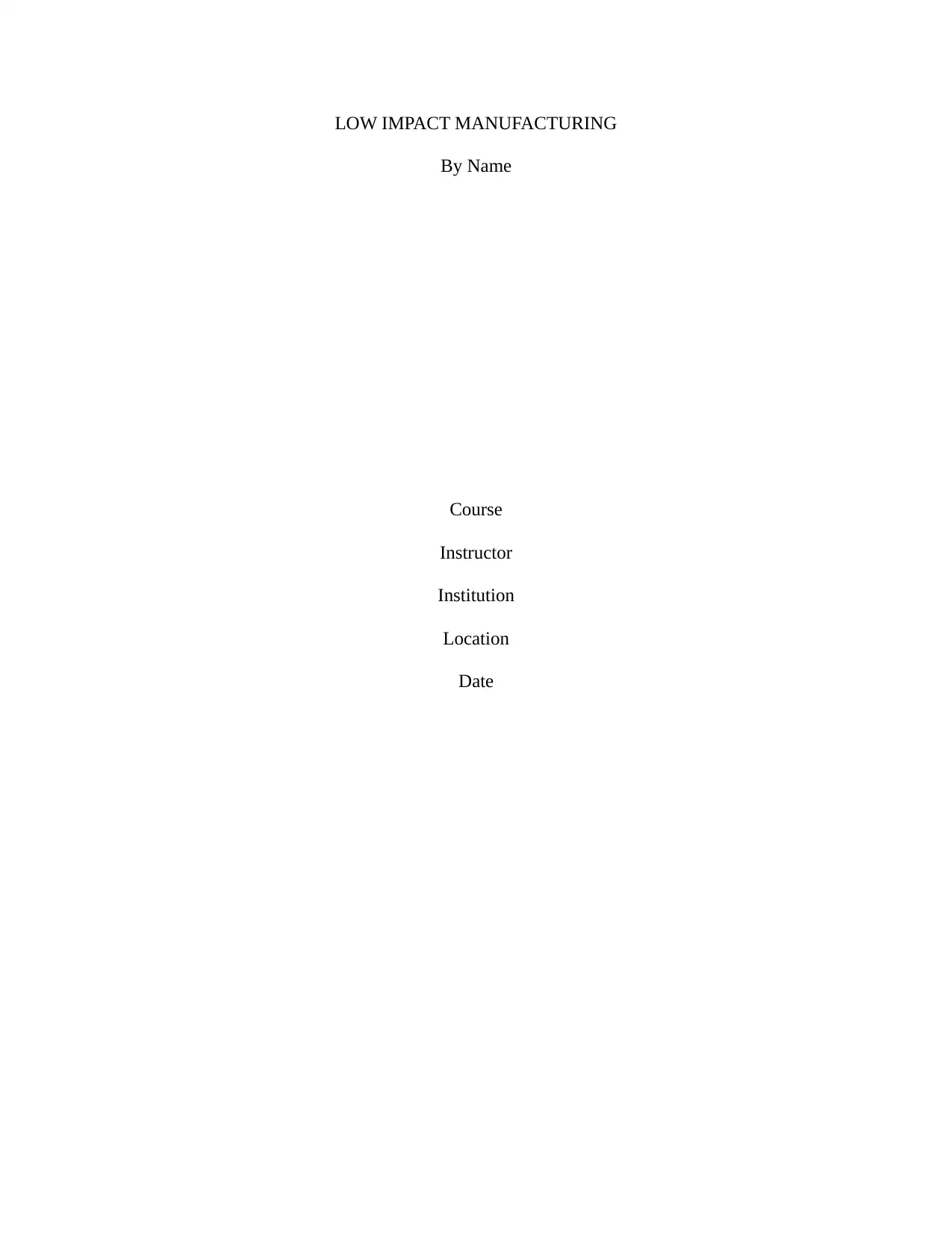
LOW IMPACT MANUFACTURING
By Name
Course
Instructor
Institution
Location
Date
By Name
Course
Instructor
Institution
Location
Date
Paraphrase This Document
Need a fresh take? Get an instant paraphrase of this document with our AI Paraphraser

Introduction
The circular economy has turned out to be one of the main challenges affecting the efficient
model of disposal. The specific model depends on the large volumes of energy alongside
resources for its effective implementation. Even though it is commonly known that the
displacement economy is the growth of the economy assumed to be long term refers to the
economic replacement of the conventional concept with the new concepts, the idea generally
promotes the development of sustainable growth. This specific technique makes use of a system
of revolutionary in the provision of economic solutions. This is attained through the elimination
of the toxic wastes, the use of renewable energy alongside the recycling of wastes on the spare
parts of a motorcycle. The notions of these techniques are attained through a motivational
mechanism that is specially designed in maintaining a comparative edge.
Large firms most likely have initiatives aimed at enacting the concepts of a circular economy, for
example, the chemical industry or even the automotive industry. Limited research work has been
carried out in an attempt to include the concept of the circular economy into the industry of the
motorcycle. The study hence aims at reducing the gap through the promotion of the notion of a
circular economy in the industry that deals with motorcycle within the geographical confines of
Britain. The previous research depending on the circular economy has been deeply checking into
the small as well as medium firms as demonstrated in the literature.
Circular economy in small and medium enterprises
The circular economy may be defined as the green economy, using resources or may be treated
as an effective way of managing resources. Various perceptions on the circular economy have
they been issues depending on the comprehensive analysis of the available literature. Most of the
The circular economy has turned out to be one of the main challenges affecting the efficient
model of disposal. The specific model depends on the large volumes of energy alongside
resources for its effective implementation. Even though it is commonly known that the
displacement economy is the growth of the economy assumed to be long term refers to the
economic replacement of the conventional concept with the new concepts, the idea generally
promotes the development of sustainable growth. This specific technique makes use of a system
of revolutionary in the provision of economic solutions. This is attained through the elimination
of the toxic wastes, the use of renewable energy alongside the recycling of wastes on the spare
parts of a motorcycle. The notions of these techniques are attained through a motivational
mechanism that is specially designed in maintaining a comparative edge.
Large firms most likely have initiatives aimed at enacting the concepts of a circular economy, for
example, the chemical industry or even the automotive industry. Limited research work has been
carried out in an attempt to include the concept of the circular economy into the industry of the
motorcycle. The study hence aims at reducing the gap through the promotion of the notion of a
circular economy in the industry that deals with motorcycle within the geographical confines of
Britain. The previous research depending on the circular economy has been deeply checking into
the small as well as medium firms as demonstrated in the literature.
Circular economy in small and medium enterprises
The circular economy may be defined as the green economy, using resources or may be treated
as an effective way of managing resources. Various perceptions on the circular economy have
they been issues depending on the comprehensive analysis of the available literature. Most of the
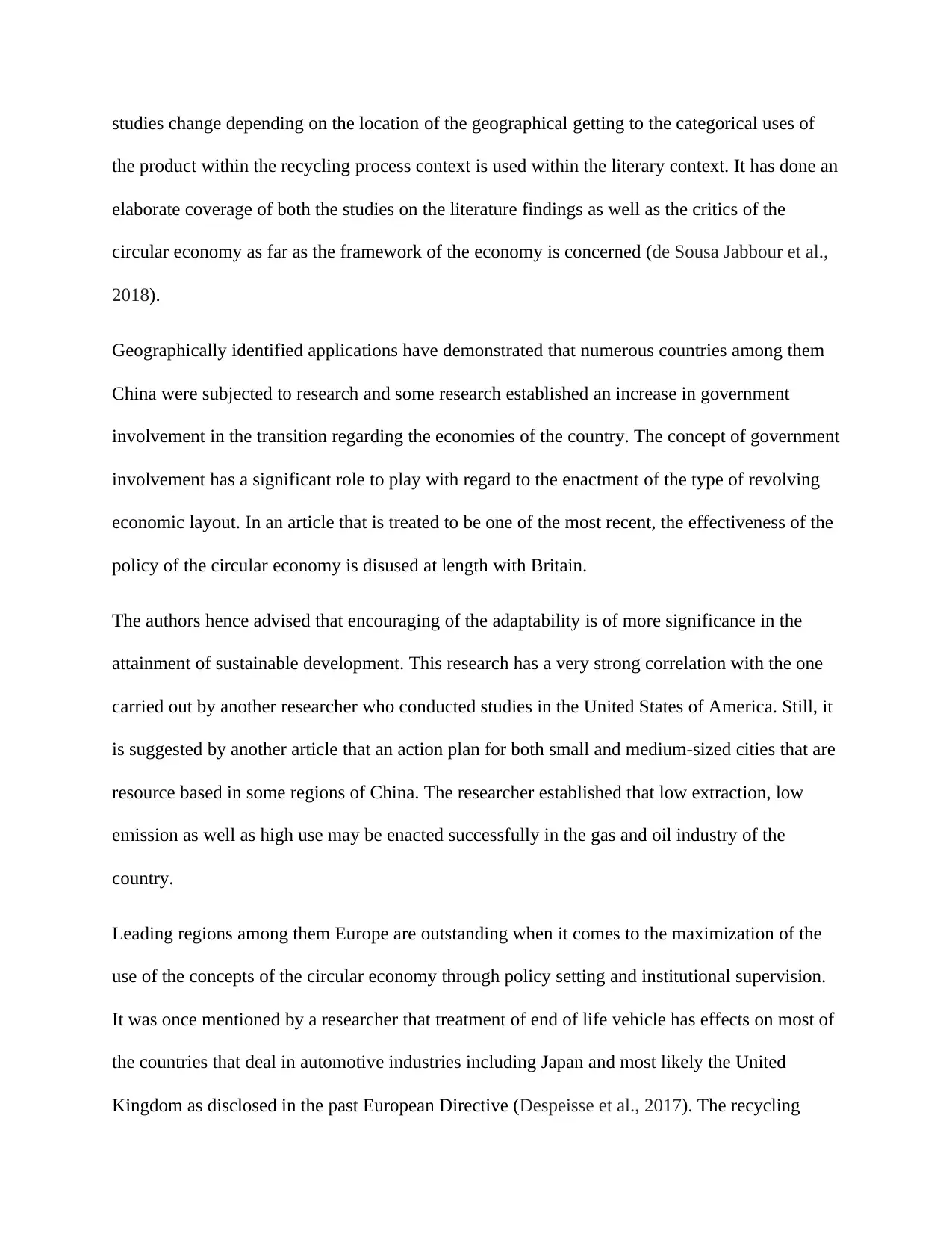
studies change depending on the location of the geographical getting to the categorical uses of
the product within the recycling process context is used within the literary context. It has done an
elaborate coverage of both the studies on the literature findings as well as the critics of the
circular economy as far as the framework of the economy is concerned (de Sousa Jabbour et al.,
2018).
Geographically identified applications have demonstrated that numerous countries among them
China were subjected to research and some research established an increase in government
involvement in the transition regarding the economies of the country. The concept of government
involvement has a significant role to play with regard to the enactment of the type of revolving
economic layout. In an article that is treated to be one of the most recent, the effectiveness of the
policy of the circular economy is disused at length with Britain.
The authors hence advised that encouraging of the adaptability is of more significance in the
attainment of sustainable development. This research has a very strong correlation with the one
carried out by another researcher who conducted studies in the United States of America. Still, it
is suggested by another article that an action plan for both small and medium-sized cities that are
resource based in some regions of China. The researcher established that low extraction, low
emission as well as high use may be enacted successfully in the gas and oil industry of the
country.
Leading regions among them Europe are outstanding when it comes to the maximization of the
use of the concepts of the circular economy through policy setting and institutional supervision.
It was once mentioned by a researcher that treatment of end of life vehicle has effects on most of
the countries that deal in automotive industries including Japan and most likely the United
Kingdom as disclosed in the past European Directive (Despeisse et al., 2017). The recycling
the product within the recycling process context is used within the literary context. It has done an
elaborate coverage of both the studies on the literature findings as well as the critics of the
circular economy as far as the framework of the economy is concerned (de Sousa Jabbour et al.,
2018).
Geographically identified applications have demonstrated that numerous countries among them
China were subjected to research and some research established an increase in government
involvement in the transition regarding the economies of the country. The concept of government
involvement has a significant role to play with regard to the enactment of the type of revolving
economic layout. In an article that is treated to be one of the most recent, the effectiveness of the
policy of the circular economy is disused at length with Britain.
The authors hence advised that encouraging of the adaptability is of more significance in the
attainment of sustainable development. This research has a very strong correlation with the one
carried out by another researcher who conducted studies in the United States of America. Still, it
is suggested by another article that an action plan for both small and medium-sized cities that are
resource based in some regions of China. The researcher established that low extraction, low
emission as well as high use may be enacted successfully in the gas and oil industry of the
country.
Leading regions among them Europe are outstanding when it comes to the maximization of the
use of the concepts of the circular economy through policy setting and institutional supervision.
It was once mentioned by a researcher that treatment of end of life vehicle has effects on most of
the countries that deal in automotive industries including Japan and most likely the United
Kingdom as disclosed in the past European Directive (Despeisse et al., 2017). The recycling
⊘ This is a preview!⊘
Do you want full access?
Subscribe today to unlock all pages.

Trusted by 1+ million students worldwide
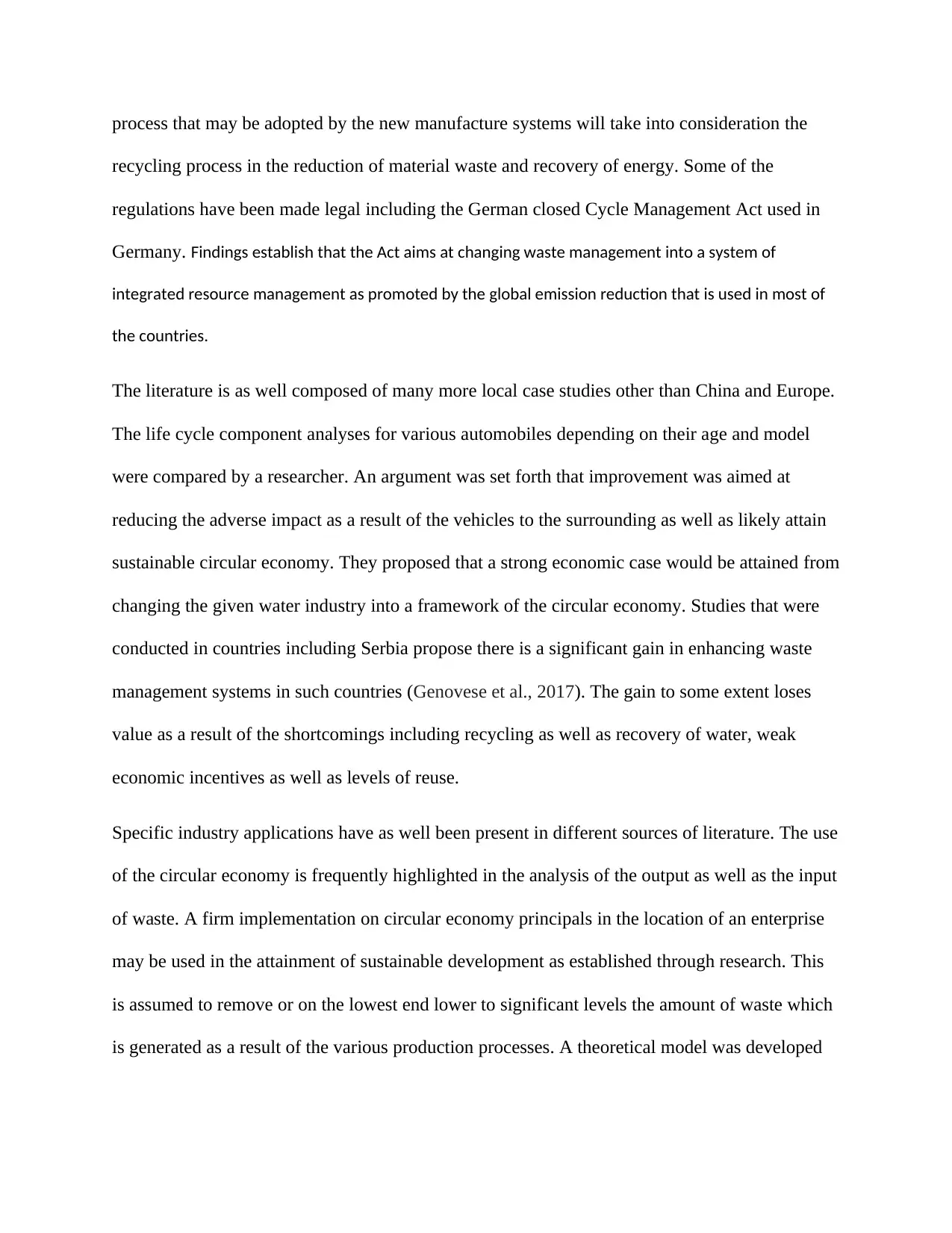
process that may be adopted by the new manufacture systems will take into consideration the
recycling process in the reduction of material waste and recovery of energy. Some of the
regulations have been made legal including the German closed Cycle Management Act used in
Germany. Findings establish that the Act aims at changing waste management into a system of
integrated resource management as promoted by the global emission reduction that is used in most of
the countries.
The literature is as well composed of many more local case studies other than China and Europe.
The life cycle component analyses for various automobiles depending on their age and model
were compared by a researcher. An argument was set forth that improvement was aimed at
reducing the adverse impact as a result of the vehicles to the surrounding as well as likely attain
sustainable circular economy. They proposed that a strong economic case would be attained from
changing the given water industry into a framework of the circular economy. Studies that were
conducted in countries including Serbia propose there is a significant gain in enhancing waste
management systems in such countries (Genovese et al., 2017). The gain to some extent loses
value as a result of the shortcomings including recycling as well as recovery of water, weak
economic incentives as well as levels of reuse.
Specific industry applications have as well been present in different sources of literature. The use
of the circular economy is frequently highlighted in the analysis of the output as well as the input
of waste. A firm implementation on circular economy principals in the location of an enterprise
may be used in the attainment of sustainable development as established through research. This
is assumed to remove or on the lowest end lower to significant levels the amount of waste which
is generated as a result of the various production processes. A theoretical model was developed
recycling process in the reduction of material waste and recovery of energy. Some of the
regulations have been made legal including the German closed Cycle Management Act used in
Germany. Findings establish that the Act aims at changing waste management into a system of
integrated resource management as promoted by the global emission reduction that is used in most of
the countries.
The literature is as well composed of many more local case studies other than China and Europe.
The life cycle component analyses for various automobiles depending on their age and model
were compared by a researcher. An argument was set forth that improvement was aimed at
reducing the adverse impact as a result of the vehicles to the surrounding as well as likely attain
sustainable circular economy. They proposed that a strong economic case would be attained from
changing the given water industry into a framework of the circular economy. Studies that were
conducted in countries including Serbia propose there is a significant gain in enhancing waste
management systems in such countries (Genovese et al., 2017). The gain to some extent loses
value as a result of the shortcomings including recycling as well as recovery of water, weak
economic incentives as well as levels of reuse.
Specific industry applications have as well been present in different sources of literature. The use
of the circular economy is frequently highlighted in the analysis of the output as well as the input
of waste. A firm implementation on circular economy principals in the location of an enterprise
may be used in the attainment of sustainable development as established through research. This
is assumed to remove or on the lowest end lower to significant levels the amount of waste which
is generated as a result of the various production processes. A theoretical model was developed
Paraphrase This Document
Need a fresh take? Get an instant paraphrase of this document with our AI Paraphraser

based on the amount of pollution and recycling. The model attempted to elaborate that the
quality of the environment may enhance with an increase in the ratio of recycling.
The findings on research on circular economy and its relation in the waste biorefinery systems
have been supported by another study proposing that waste may be changed into a renewable
substance which recovers the bio-based energy through sustainable mechanisms. Some of the
findings established that biorefinery was wastes used in the generation of chemicals, energy as
well as fuels that are closely linked to the mechanisms that are in support of the circular
adaptation theory.
Research conducted by numerous researchers attempted to demonstrate how material and energy
efficiency may be attained in some industries, for example, the paper mill industry in Britain
(Winans, Kendall, and Deng, 2017). The concept may as well as assist in the motorcycle industry
specifically in Britain. Some of the common circular economies are among them minerals
including gold, silver, and platinum. The process, nevertheless, does not work independently but
rather needs other substances including nickel, zinc, cobalt, and tin among others to enable
recycling from them. The researchers proposed that the production manager needs to promote
longer lifetime use besides increasing the levels of product returns for initial use in a bid to attain
higher levels of recycling. Numerous articles elaborate the economic, theoretical and political
framework of circular economy as was once argued by a researcher that a circular economy finds
a theoretical framework within the classical political economy theory Winans, Kendall, and
Deng, 2017).
The difference between economic circulation and circular economy is clearly outlined by some
researchers who state that the recirculation of resources to make different products may not
necessarily be the circular economy. Rather, a manufactured is needed to carry out recycling
quality of the environment may enhance with an increase in the ratio of recycling.
The findings on research on circular economy and its relation in the waste biorefinery systems
have been supported by another study proposing that waste may be changed into a renewable
substance which recovers the bio-based energy through sustainable mechanisms. Some of the
findings established that biorefinery was wastes used in the generation of chemicals, energy as
well as fuels that are closely linked to the mechanisms that are in support of the circular
adaptation theory.
Research conducted by numerous researchers attempted to demonstrate how material and energy
efficiency may be attained in some industries, for example, the paper mill industry in Britain
(Winans, Kendall, and Deng, 2017). The concept may as well as assist in the motorcycle industry
specifically in Britain. Some of the common circular economies are among them minerals
including gold, silver, and platinum. The process, nevertheless, does not work independently but
rather needs other substances including nickel, zinc, cobalt, and tin among others to enable
recycling from them. The researchers proposed that the production manager needs to promote
longer lifetime use besides increasing the levels of product returns for initial use in a bid to attain
higher levels of recycling. Numerous articles elaborate the economic, theoretical and political
framework of circular economy as was once argued by a researcher that a circular economy finds
a theoretical framework within the classical political economy theory Winans, Kendall, and
Deng, 2017).
The difference between economic circulation and circular economy is clearly outlined by some
researchers who state that the recirculation of resources to make different products may not
necessarily be the circular economy. Rather, a manufactured is needed to carry out recycling
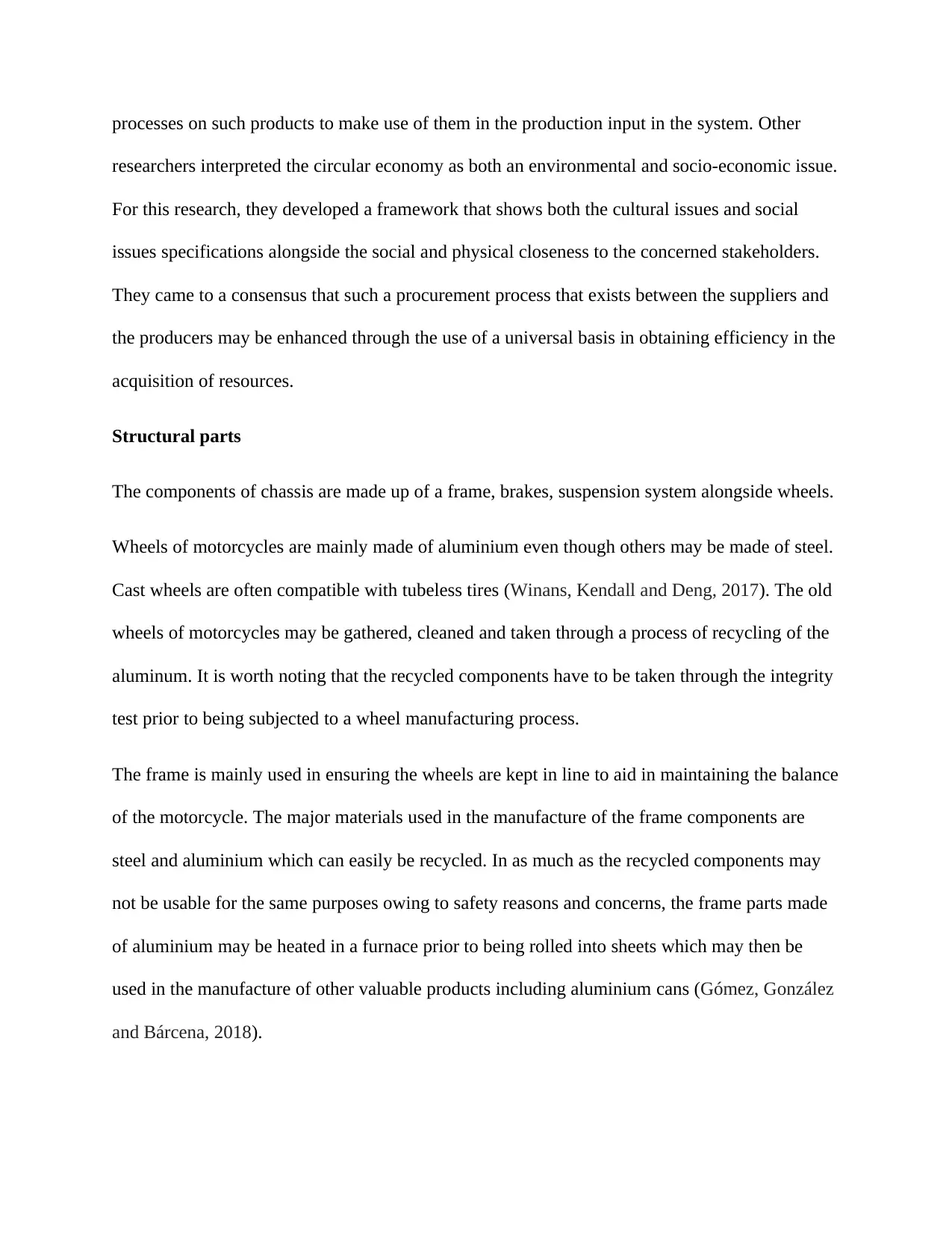
processes on such products to make use of them in the production input in the system. Other
researchers interpreted the circular economy as both an environmental and socio-economic issue.
For this research, they developed a framework that shows both the cultural issues and social
issues specifications alongside the social and physical closeness to the concerned stakeholders.
They came to a consensus that such a procurement process that exists between the suppliers and
the producers may be enhanced through the use of a universal basis in obtaining efficiency in the
acquisition of resources.
Structural parts
The components of chassis are made up of a frame, brakes, suspension system alongside wheels.
Wheels of motorcycles are mainly made of aluminium even though others may be made of steel.
Cast wheels are often compatible with tubeless tires (Winans, Kendall and Deng, 2017). The old
wheels of motorcycles may be gathered, cleaned and taken through a process of recycling of the
aluminum. It is worth noting that the recycled components have to be taken through the integrity
test prior to being subjected to a wheel manufacturing process.
The frame is mainly used in ensuring the wheels are kept in line to aid in maintaining the balance
of the motorcycle. The major materials used in the manufacture of the frame components are
steel and aluminium which can easily be recycled. In as much as the recycled components may
not be usable for the same purposes owing to safety reasons and concerns, the frame parts made
of aluminium may be heated in a furnace prior to being rolled into sheets which may then be
used in the manufacture of other valuable products including aluminium cans (Gómez, González
and Bárcena, 2018).
researchers interpreted the circular economy as both an environmental and socio-economic issue.
For this research, they developed a framework that shows both the cultural issues and social
issues specifications alongside the social and physical closeness to the concerned stakeholders.
They came to a consensus that such a procurement process that exists between the suppliers and
the producers may be enhanced through the use of a universal basis in obtaining efficiency in the
acquisition of resources.
Structural parts
The components of chassis are made up of a frame, brakes, suspension system alongside wheels.
Wheels of motorcycles are mainly made of aluminium even though others may be made of steel.
Cast wheels are often compatible with tubeless tires (Winans, Kendall and Deng, 2017). The old
wheels of motorcycles may be gathered, cleaned and taken through a process of recycling of the
aluminum. It is worth noting that the recycled components have to be taken through the integrity
test prior to being subjected to a wheel manufacturing process.
The frame is mainly used in ensuring the wheels are kept in line to aid in maintaining the balance
of the motorcycle. The major materials used in the manufacture of the frame components are
steel and aluminium which can easily be recycled. In as much as the recycled components may
not be usable for the same purposes owing to safety reasons and concerns, the frame parts made
of aluminium may be heated in a furnace prior to being rolled into sheets which may then be
used in the manufacture of other valuable products including aluminium cans (Gómez, González
and Bárcena, 2018).
⊘ This is a preview!⊘
Do you want full access?
Subscribe today to unlock all pages.

Trusted by 1+ million students worldwide

Suspension defines a group of shock absorbers and springs which aid in ensuring the wheels
remain in contact with the roads besides cushioning the rider against bumps and jolts.
Suspensions are manufactured using steel which can be recycled and used for other purposes.
Brakes are found in both the rear as well as front wheels of the motorcycle with the rear brake
often being activated with the use of the foot pedal (Winans, Kendall and Deng, 2017). Steel
materials are used in the manufacture of the disc brakes. Steel is one of the most recycled
materials around the world hence the old and worn out parts of the disc brake should be recycled
as opposed to being disposed of. The components should be taken through the recycling process
which is a factor of metallurgical property tests to enable them to be used in the manufacture of
new products.
The seat assembly is made using steel and is normally design for the purposes of carrying a
passenger or two. The old seat assembly may be subjected to the process of steel recycling as
well as integrity tests conducted prior to being used in the production of new components. The
most appropriate chemicals should be added in the treatment process to ascertain quality
maintenance.
Electrical components
Defective wires, circuit boards, motors, and switches should not be disposed by the management
of the motorcycle manufacturing plant but rather be gathered and kept safe before being taken
back to the manufacturer for the purposes of the recycling process
Batteries are in most cases got from external firms hence resulting in significantly increased the
cost of manufacture. Smelting furnaces should be used in heating lead oxides and lead grids
alongside the other motorcycle battery components (Korhonen, Honkasalo and Seppälä, 2018).
remain in contact with the roads besides cushioning the rider against bumps and jolts.
Suspensions are manufactured using steel which can be recycled and used for other purposes.
Brakes are found in both the rear as well as front wheels of the motorcycle with the rear brake
often being activated with the use of the foot pedal (Winans, Kendall and Deng, 2017). Steel
materials are used in the manufacture of the disc brakes. Steel is one of the most recycled
materials around the world hence the old and worn out parts of the disc brake should be recycled
as opposed to being disposed of. The components should be taken through the recycling process
which is a factor of metallurgical property tests to enable them to be used in the manufacture of
new products.
The seat assembly is made using steel and is normally design for the purposes of carrying a
passenger or two. The old seat assembly may be subjected to the process of steel recycling as
well as integrity tests conducted prior to being used in the production of new components. The
most appropriate chemicals should be added in the treatment process to ascertain quality
maintenance.
Electrical components
Defective wires, circuit boards, motors, and switches should not be disposed by the management
of the motorcycle manufacturing plant but rather be gathered and kept safe before being taken
back to the manufacturer for the purposes of the recycling process
Batteries are in most cases got from external firms hence resulting in significantly increased the
cost of manufacture. Smelting furnaces should be used in heating lead oxides and lead grids
alongside the other motorcycle battery components (Korhonen, Honkasalo and Seppälä, 2018).
Paraphrase This Document
Need a fresh take? Get an instant paraphrase of this document with our AI Paraphraser
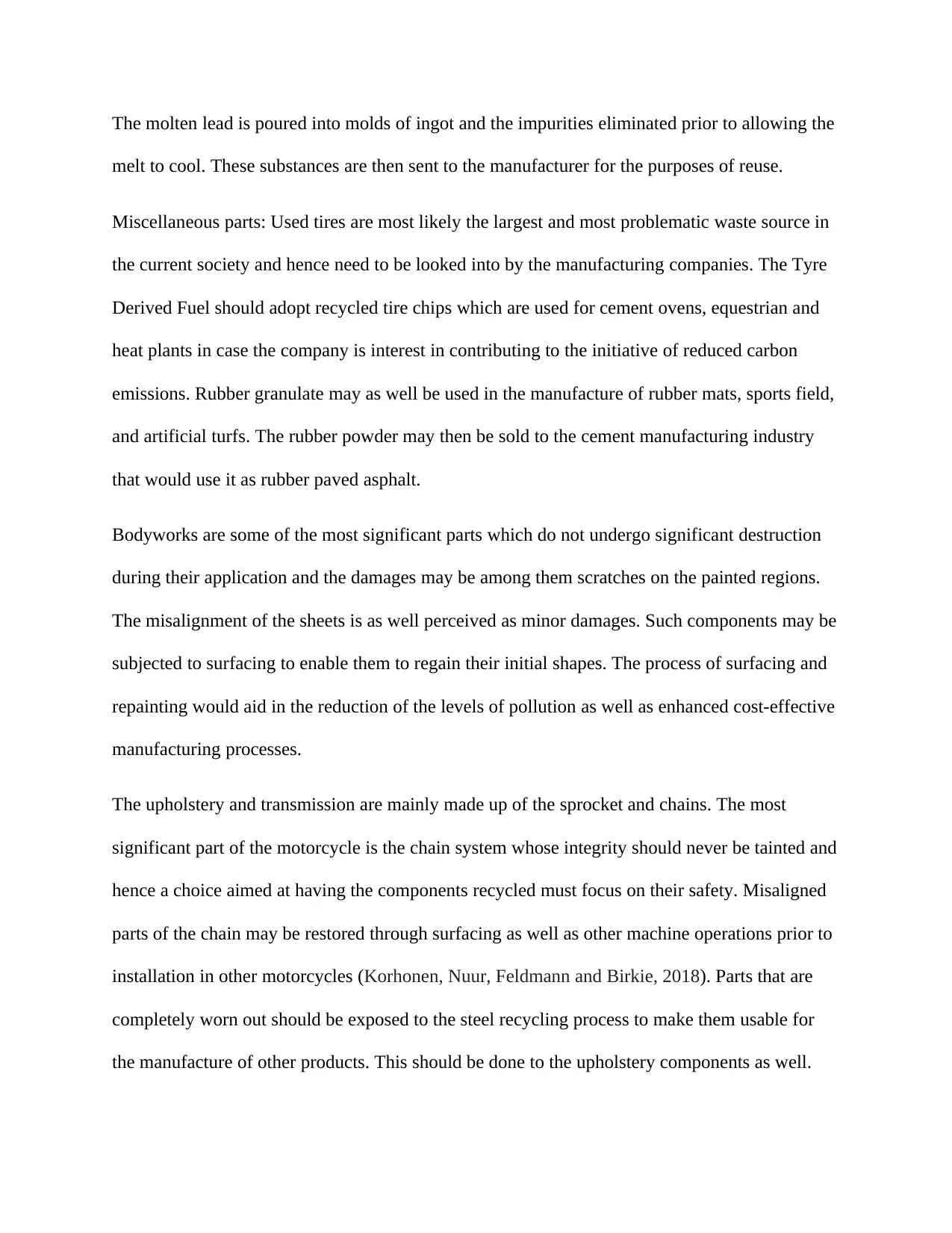
The molten lead is poured into molds of ingot and the impurities eliminated prior to allowing the
melt to cool. These substances are then sent to the manufacturer for the purposes of reuse.
Miscellaneous parts: Used tires are most likely the largest and most problematic waste source in
the current society and hence need to be looked into by the manufacturing companies. The Tyre
Derived Fuel should adopt recycled tire chips which are used for cement ovens, equestrian and
heat plants in case the company is interest in contributing to the initiative of reduced carbon
emissions. Rubber granulate may as well be used in the manufacture of rubber mats, sports field,
and artificial turfs. The rubber powder may then be sold to the cement manufacturing industry
that would use it as rubber paved asphalt.
Bodyworks are some of the most significant parts which do not undergo significant destruction
during their application and the damages may be among them scratches on the painted regions.
The misalignment of the sheets is as well perceived as minor damages. Such components may be
subjected to surfacing to enable them to regain their initial shapes. The process of surfacing and
repainting would aid in the reduction of the levels of pollution as well as enhanced cost-effective
manufacturing processes.
The upholstery and transmission are mainly made up of the sprocket and chains. The most
significant part of the motorcycle is the chain system whose integrity should never be tainted and
hence a choice aimed at having the components recycled must focus on their safety. Misaligned
parts of the chain may be restored through surfacing as well as other machine operations prior to
installation in other motorcycles (Korhonen, Nuur, Feldmann and Birkie, 2018). Parts that are
completely worn out should be exposed to the steel recycling process to make them usable for
the manufacture of other products. This should be done to the upholstery components as well.
melt to cool. These substances are then sent to the manufacturer for the purposes of reuse.
Miscellaneous parts: Used tires are most likely the largest and most problematic waste source in
the current society and hence need to be looked into by the manufacturing companies. The Tyre
Derived Fuel should adopt recycled tire chips which are used for cement ovens, equestrian and
heat plants in case the company is interest in contributing to the initiative of reduced carbon
emissions. Rubber granulate may as well be used in the manufacture of rubber mats, sports field,
and artificial turfs. The rubber powder may then be sold to the cement manufacturing industry
that would use it as rubber paved asphalt.
Bodyworks are some of the most significant parts which do not undergo significant destruction
during their application and the damages may be among them scratches on the painted regions.
The misalignment of the sheets is as well perceived as minor damages. Such components may be
subjected to surfacing to enable them to regain their initial shapes. The process of surfacing and
repainting would aid in the reduction of the levels of pollution as well as enhanced cost-effective
manufacturing processes.
The upholstery and transmission are mainly made up of the sprocket and chains. The most
significant part of the motorcycle is the chain system whose integrity should never be tainted and
hence a choice aimed at having the components recycled must focus on their safety. Misaligned
parts of the chain may be restored through surfacing as well as other machine operations prior to
installation in other motorcycles (Korhonen, Nuur, Feldmann and Birkie, 2018). Parts that are
completely worn out should be exposed to the steel recycling process to make them usable for
the manufacture of other products. This should be done to the upholstery components as well.
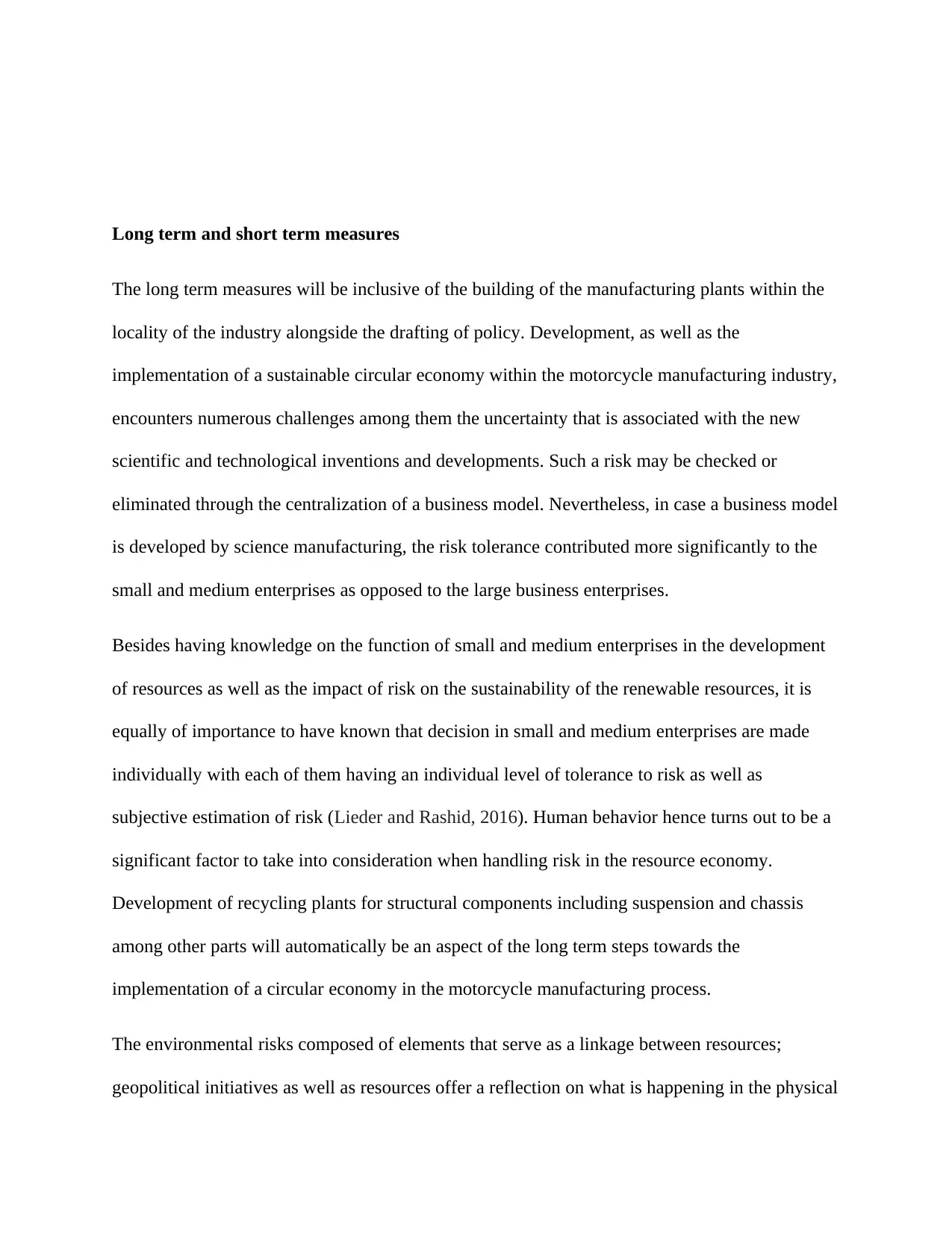
Long term and short term measures
The long term measures will be inclusive of the building of the manufacturing plants within the
locality of the industry alongside the drafting of policy. Development, as well as the
implementation of a sustainable circular economy within the motorcycle manufacturing industry,
encounters numerous challenges among them the uncertainty that is associated with the new
scientific and technological inventions and developments. Such a risk may be checked or
eliminated through the centralization of a business model. Nevertheless, in case a business model
is developed by science manufacturing, the risk tolerance contributed more significantly to the
small and medium enterprises as opposed to the large business enterprises.
Besides having knowledge on the function of small and medium enterprises in the development
of resources as well as the impact of risk on the sustainability of the renewable resources, it is
equally of importance to have known that decision in small and medium enterprises are made
individually with each of them having an individual level of tolerance to risk as well as
subjective estimation of risk (Lieder and Rashid, 2016). Human behavior hence turns out to be a
significant factor to take into consideration when handling risk in the resource economy.
Development of recycling plants for structural components including suspension and chassis
among other parts will automatically be an aspect of the long term steps towards the
implementation of a circular economy in the motorcycle manufacturing process.
The environmental risks composed of elements that serve as a linkage between resources;
geopolitical initiatives as well as resources offer a reflection on what is happening in the physical
The long term measures will be inclusive of the building of the manufacturing plants within the
locality of the industry alongside the drafting of policy. Development, as well as the
implementation of a sustainable circular economy within the motorcycle manufacturing industry,
encounters numerous challenges among them the uncertainty that is associated with the new
scientific and technological inventions and developments. Such a risk may be checked or
eliminated through the centralization of a business model. Nevertheless, in case a business model
is developed by science manufacturing, the risk tolerance contributed more significantly to the
small and medium enterprises as opposed to the large business enterprises.
Besides having knowledge on the function of small and medium enterprises in the development
of resources as well as the impact of risk on the sustainability of the renewable resources, it is
equally of importance to have known that decision in small and medium enterprises are made
individually with each of them having an individual level of tolerance to risk as well as
subjective estimation of risk (Lieder and Rashid, 2016). Human behavior hence turns out to be a
significant factor to take into consideration when handling risk in the resource economy.
Development of recycling plants for structural components including suspension and chassis
among other parts will automatically be an aspect of the long term steps towards the
implementation of a circular economy in the motorcycle manufacturing process.
The environmental risks composed of elements that serve as a linkage between resources;
geopolitical initiatives as well as resources offer a reflection on what is happening in the physical
⊘ This is a preview!⊘
Do you want full access?
Subscribe today to unlock all pages.

Trusted by 1+ million students worldwide
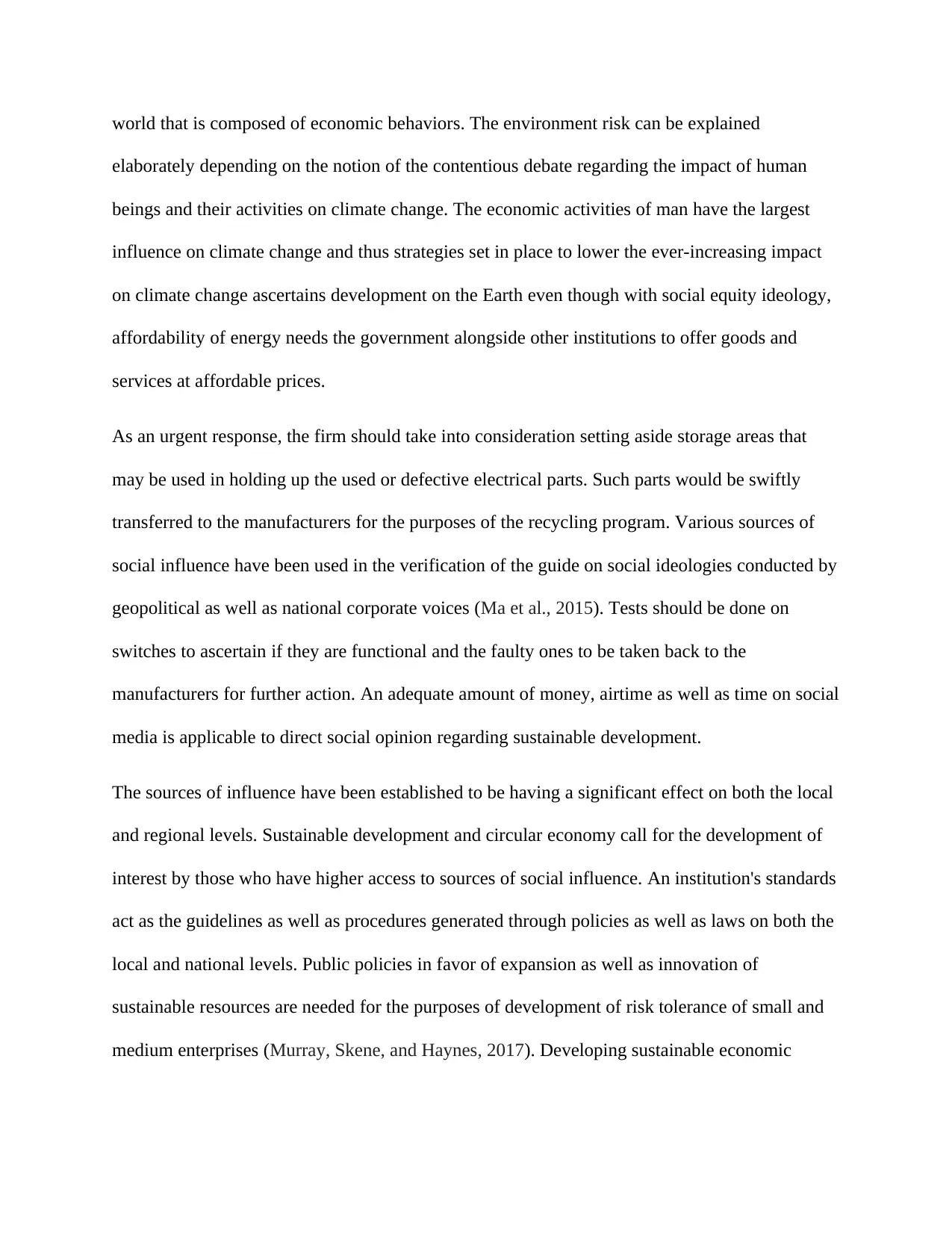
world that is composed of economic behaviors. The environment risk can be explained
elaborately depending on the notion of the contentious debate regarding the impact of human
beings and their activities on climate change. The economic activities of man have the largest
influence on climate change and thus strategies set in place to lower the ever-increasing impact
on climate change ascertains development on the Earth even though with social equity ideology,
affordability of energy needs the government alongside other institutions to offer goods and
services at affordable prices.
As an urgent response, the firm should take into consideration setting aside storage areas that
may be used in holding up the used or defective electrical parts. Such parts would be swiftly
transferred to the manufacturers for the purposes of the recycling program. Various sources of
social influence have been used in the verification of the guide on social ideologies conducted by
geopolitical as well as national corporate voices (Ma et al., 2015). Tests should be done on
switches to ascertain if they are functional and the faulty ones to be taken back to the
manufacturers for further action. An adequate amount of money, airtime as well as time on social
media is applicable to direct social opinion regarding sustainable development.
The sources of influence have been established to be having a significant effect on both the local
and regional levels. Sustainable development and circular economy call for the development of
interest by those who have higher access to sources of social influence. An institution's standards
act as the guidelines as well as procedures generated through policies as well as laws on both the
local and national levels. Public policies in favor of expansion as well as innovation of
sustainable resources are needed for the purposes of development of risk tolerance of small and
medium enterprises (Murray, Skene, and Haynes, 2017). Developing sustainable economic
elaborately depending on the notion of the contentious debate regarding the impact of human
beings and their activities on climate change. The economic activities of man have the largest
influence on climate change and thus strategies set in place to lower the ever-increasing impact
on climate change ascertains development on the Earth even though with social equity ideology,
affordability of energy needs the government alongside other institutions to offer goods and
services at affordable prices.
As an urgent response, the firm should take into consideration setting aside storage areas that
may be used in holding up the used or defective electrical parts. Such parts would be swiftly
transferred to the manufacturers for the purposes of the recycling program. Various sources of
social influence have been used in the verification of the guide on social ideologies conducted by
geopolitical as well as national corporate voices (Ma et al., 2015). Tests should be done on
switches to ascertain if they are functional and the faulty ones to be taken back to the
manufacturers for further action. An adequate amount of money, airtime as well as time on social
media is applicable to direct social opinion regarding sustainable development.
The sources of influence have been established to be having a significant effect on both the local
and regional levels. Sustainable development and circular economy call for the development of
interest by those who have higher access to sources of social influence. An institution's standards
act as the guidelines as well as procedures generated through policies as well as laws on both the
local and national levels. Public policies in favor of expansion as well as innovation of
sustainable resources are needed for the purposes of development of risk tolerance of small and
medium enterprises (Murray, Skene, and Haynes, 2017). Developing sustainable economic
Paraphrase This Document
Need a fresh take? Get an instant paraphrase of this document with our AI Paraphraser

strategies as well as behaviors perceive risk as demonstrated by the motorcycle industry in case
the policies are ambivalent to the impact of normative pressure as well as social influence.
Normative pressures low effective communication as well as interaction in the environment.
Introduction of an innovation that contradicts the custom model of economic behavior may result
in alienation as the users are often controlled by their nature towards what they may depend on
hence eversion to the risk of decision makers in the motorcycle industry would rise to suppose
novel technologies promoting circular economy is introduced with the aim of solving self-
protecting localism in geopolitical trends.
Working with the miscellaneous parts including the transmission, tires, bodywork as well as
upholstery would be innovatively conducted taking into consideration they make up the
secondary components. The company would find it a necessity to install a lathe machine
alongside other bodywork. Recent undertakings that are treated to be of low risk by small and
medium enterprises are demonstrated by past activities. All the strategies towards the
development of sustainable economic resources as well as innovation have what is seemingly a
direct impact on the adoption of the circular economy on the manufacturing industry even as the
proximal attitude has no direct effects on the economic behaviors of direct competition (Winans,
Kendall and Deng, 2017). For example, a competitor having more risk tolerance may be said to
be a success in the implementation of a new economic model that would be encouraging to other
small and medium enterprises. The company should as well develop tire recycling plants as an
involuntary process within the policy framework.
Future sustainable industrial plan
the policies are ambivalent to the impact of normative pressure as well as social influence.
Normative pressures low effective communication as well as interaction in the environment.
Introduction of an innovation that contradicts the custom model of economic behavior may result
in alienation as the users are often controlled by their nature towards what they may depend on
hence eversion to the risk of decision makers in the motorcycle industry would rise to suppose
novel technologies promoting circular economy is introduced with the aim of solving self-
protecting localism in geopolitical trends.
Working with the miscellaneous parts including the transmission, tires, bodywork as well as
upholstery would be innovatively conducted taking into consideration they make up the
secondary components. The company would find it a necessity to install a lathe machine
alongside other bodywork. Recent undertakings that are treated to be of low risk by small and
medium enterprises are demonstrated by past activities. All the strategies towards the
development of sustainable economic resources as well as innovation have what is seemingly a
direct impact on the adoption of the circular economy on the manufacturing industry even as the
proximal attitude has no direct effects on the economic behaviors of direct competition (Winans,
Kendall and Deng, 2017). For example, a competitor having more risk tolerance may be said to
be a success in the implementation of a new economic model that would be encouraging to other
small and medium enterprises. The company should as well develop tire recycling plants as an
involuntary process within the policy framework.
Future sustainable industrial plan
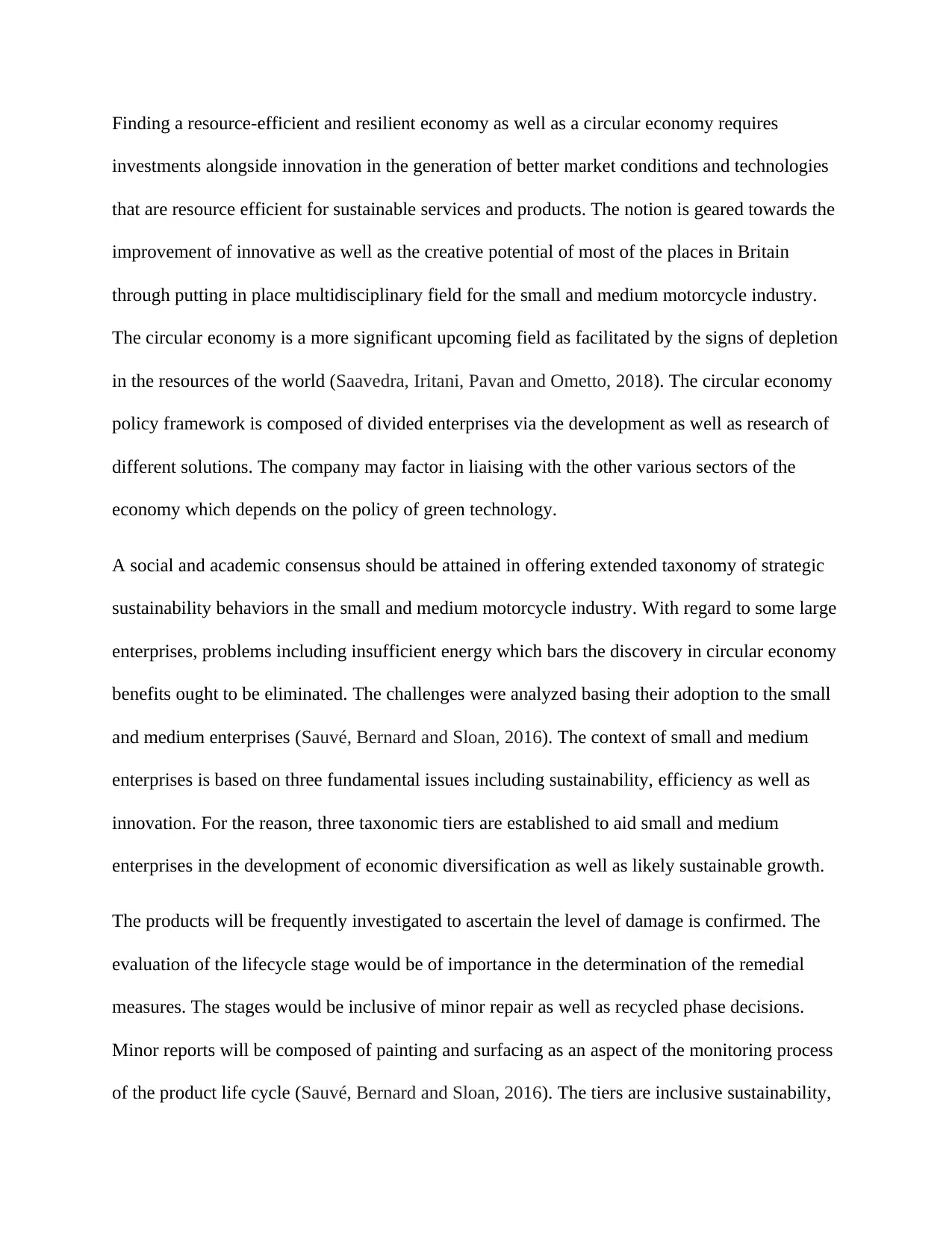
Finding a resource-efficient and resilient economy as well as a circular economy requires
investments alongside innovation in the generation of better market conditions and technologies
that are resource efficient for sustainable services and products. The notion is geared towards the
improvement of innovative as well as the creative potential of most of the places in Britain
through putting in place multidisciplinary field for the small and medium motorcycle industry.
The circular economy is a more significant upcoming field as facilitated by the signs of depletion
in the resources of the world (Saavedra, Iritani, Pavan and Ometto, 2018). The circular economy
policy framework is composed of divided enterprises via the development as well as research of
different solutions. The company may factor in liaising with the other various sectors of the
economy which depends on the policy of green technology.
A social and academic consensus should be attained in offering extended taxonomy of strategic
sustainability behaviors in the small and medium motorcycle industry. With regard to some large
enterprises, problems including insufficient energy which bars the discovery in circular economy
benefits ought to be eliminated. The challenges were analyzed basing their adoption to the small
and medium enterprises (Sauvé, Bernard and Sloan, 2016). The context of small and medium
enterprises is based on three fundamental issues including sustainability, efficiency as well as
innovation. For the reason, three taxonomic tiers are established to aid small and medium
enterprises in the development of economic diversification as well as likely sustainable growth.
The products will be frequently investigated to ascertain the level of damage is confirmed. The
evaluation of the lifecycle stage would be of importance in the determination of the remedial
measures. The stages would be inclusive of minor repair as well as recycled phase decisions.
Minor reports will be composed of painting and surfacing as an aspect of the monitoring process
of the product life cycle (Sauvé, Bernard and Sloan, 2016). The tiers are inclusive sustainability,
investments alongside innovation in the generation of better market conditions and technologies
that are resource efficient for sustainable services and products. The notion is geared towards the
improvement of innovative as well as the creative potential of most of the places in Britain
through putting in place multidisciplinary field for the small and medium motorcycle industry.
The circular economy is a more significant upcoming field as facilitated by the signs of depletion
in the resources of the world (Saavedra, Iritani, Pavan and Ometto, 2018). The circular economy
policy framework is composed of divided enterprises via the development as well as research of
different solutions. The company may factor in liaising with the other various sectors of the
economy which depends on the policy of green technology.
A social and academic consensus should be attained in offering extended taxonomy of strategic
sustainability behaviors in the small and medium motorcycle industry. With regard to some large
enterprises, problems including insufficient energy which bars the discovery in circular economy
benefits ought to be eliminated. The challenges were analyzed basing their adoption to the small
and medium enterprises (Sauvé, Bernard and Sloan, 2016). The context of small and medium
enterprises is based on three fundamental issues including sustainability, efficiency as well as
innovation. For the reason, three taxonomic tiers are established to aid small and medium
enterprises in the development of economic diversification as well as likely sustainable growth.
The products will be frequently investigated to ascertain the level of damage is confirmed. The
evaluation of the lifecycle stage would be of importance in the determination of the remedial
measures. The stages would be inclusive of minor repair as well as recycled phase decisions.
Minor reports will be composed of painting and surfacing as an aspect of the monitoring process
of the product life cycle (Sauvé, Bernard and Sloan, 2016). The tiers are inclusive sustainability,
⊘ This is a preview!⊘
Do you want full access?
Subscribe today to unlock all pages.

Trusted by 1+ million students worldwide
1 out of 17
Related Documents
Your All-in-One AI-Powered Toolkit for Academic Success.
+13062052269
info@desklib.com
Available 24*7 on WhatsApp / Email
![[object Object]](/_next/static/media/star-bottom.7253800d.svg)
Unlock your academic potential
Copyright © 2020–2025 A2Z Services. All Rights Reserved. Developed and managed by ZUCOL.





